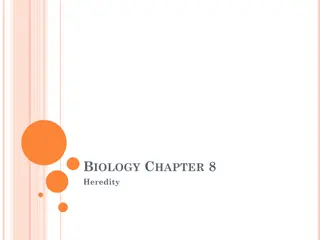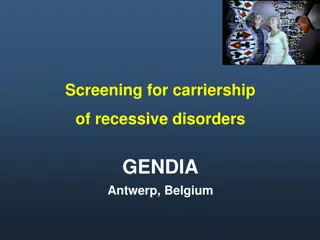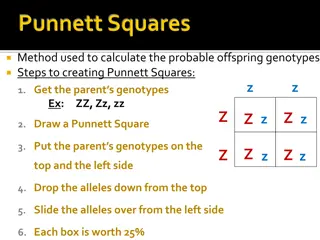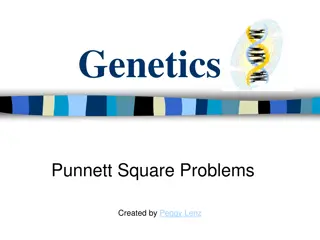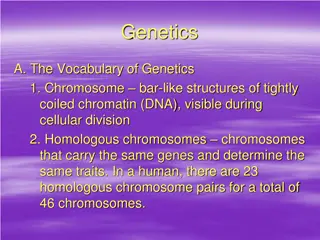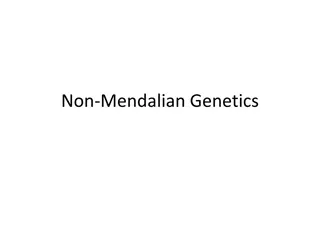Understanding Trait Inheritance for Real-World Problem Solving
Discover how the study of trait inheritance in genetics helps solve real-world problems through examples like the Wilson family case study. Explore key concepts such as chromosomes, genes, alleles, dominant and recessive traits, and the Hansen family pedigree to grasp the significance of genetic inh
0 views • 13 slides
Overview of Human Genetic Disorders
Human genetic disorders encompass a range of conditions, from recessive disorders like cystic fibrosis to dominant disorders such as Huntington's disease. Examples include cystic fibrosis, Huntington's disease, and sickle-cell anemia. Understanding genetic disorders involves research and awareness o
0 views • 10 slides
Understanding Mendelian Human Genetic Traits
Explore various Mendelian human genetic traits such as tongue rolling, attached earlobes, interlocking fingers, dimples, sex determination, bent little finger, hitchhiker thumb, freckles, widow's peak, PTC taste sensitivity, sodium benzoate taste sensitivity, and thiourea taste sensitivity. Understa
0 views • 13 slides
Understanding Mendel's Experiments and Principles of Genetics
Delve into the pioneering work of Gregor Mendel, the father of genetics, as he conducted groundbreaking experiments with pea plants, identified key principles of genetics, and introduced the concept of dominant and recessive traits. Explore how Mendel's work laid the foundation for our understanding
4 views • 23 slides
Understanding Mixtures and Separation Techniques
Explore the concepts of mixtures and separation, from the definition of dominant and recessive alleles to the advantages of electron microscopes. Learn about identifying pure substances, differences between pure and impure substances, and techniques like filtration and crystallization for separation
1 views • 19 slides
Understanding Epistasis: Types and Inferences
Epistasis is the interaction between genes where one gene's allele masks the expression of another gene. Various types of epistasis, such as dominant and recessive epistasis, can be observed, impacting the phenotypic ratios. Statistical inferences can help analyze epistatic interactions in genetic s
0 views • 35 slides
Understanding Lethal Alleles and Multiple Alleles in Genetics
Lethal alleles are mutant genes that result in the death of individuals carrying them, either in prenatal or postnatal stages. Both dominant and recessive lethal alleles have distinct effects on the population genetics. Examples in plants like snapdragons and maize demonstrate how lethal alleles imp
0 views • 18 slides
Genetic Findings in a Female Patient with Developmental Disorders
A 3-year-old female patient (Case V) with postnatal growth deficiency, VSD, scoliosis, hand anomalies, hearing loss, and craniofacial dysmorphism was referred for genomic microarray testing. Maternal inheritance of a CNV was identified. Research on PTCHD1 disruptions in males and carrier females hig
0 views • 12 slides
Genetic Carrier Screening for Recessive Disorders by GENDIA, Antwerp, Belgium
Explore the world of genetic carrier screening offered by GENDIA in Antwerp, Belgium. Learn about prenatal screening for various genetic disorders, including Down syndrome and severe monogenic disorders. Discover the frequency of common recessive disorders and the severity of genetic diseases. Uncov
0 views • 17 slides
Understanding Punnett Squares for Predicting Offspring Genotypes
Punnett squares are a visual tool used to predict the possible genotypes and phenotypes of offspring based on the parent's genetic makeup. By following simple steps and understanding dominant and recessive traits, you can calculate the likelihood of different genetic outcomes for traits like hair co
0 views • 7 slides
Genetics Punnett Square Problems Explained
Explore Punnett Square problems involving genetic traits such as fur color in mice, number of eyes in aliens, seed production in tomato plants, and tail length in cats. Understand dominant and recessive gene interactions through visual examples and answer key explanations.
0 views • 14 slides
Understanding Hardy-Weinberg Principle and Genetic Frequencies
Gene pool and allele frequencies play a crucial role in the Hardy-Weinberg Principle, a mathematical model predicting allele frequencies over generations. The principle outlines conditions like a large population, absence of mutations, random mating, and more. Equations such as p² + 2pq + q² = 1 h
0 views • 44 slides
Genetics Quiz Questions on Heredity and Inheritance
Test your knowledge on genetics with these quiz questions covering topics like Mendelian laws, dominant and recessive traits, gamete formation probabilities, and genetic crosses. Explore concepts such as allelic inheritance, phenotypic ratios, and genetic probabilities in various scenarios. Improve
1 views • 79 slides
Understanding Genetics: Chromosomes, Genes, and Inheritance
Genetics encompasses the study of chromosomes, genes, and inheritance patterns. Chromosomes are bar-like structures carrying DNA, with homologous pairs determining traits. Autosomes and sex chromosomes play roles in genetic makeup. Genes are hereditary units determining individual traits, with allel
0 views • 20 slides
Understanding Epistasis: Genetic Interactions and Their Implications
Epistasis is a phenomenon where the phenotypic expression of one gene is influenced by interactions with another gene. This concept, first introduced in 1909, plays a crucial role in genetics, affecting various traits and evolutionary processes. The difference between dominance and epistasis lies in
0 views • 41 slides
SpongeBob Genetics Review Questions & Phenotype Determination
Explore genetics concepts using SpongeBob-themed questions to differentiate between heterozygous and homozygous genotypes, identify purebred and hybrid genotypes, and determine phenotypes based on dominant and recessive traits like body color and shape.
0 views • 17 slides
The Legacy of Gregor Mendel: Father of Genetics and Pea Plant Experiments
Gregor Mendel, a monk from the 1800s, conducted groundbreaking experiments with pea plants to study inheritance patterns. By meticulously observing traits like seed color and pod shape, Mendel discovered the principles of heredity and laid the foundation for modern genetics. His work on dominant and
0 views • 33 slides
Understanding Color Blindness: Causes, Symptoms, and Diagnosis
Color blindness, also known as color vision deficiency, is a genetic disorder that affects the ability to distinguish between colors. John Dalton discovered color blindness in 1794. It is inherited in an X-linked recessive pattern and can cause difficulties in daily life, such as trouble seeing colo
0 views • 13 slides
Gregor Mendel and His Work with Pea Plants
Gregor Mendel, an Austrian monk born in 1822, is known as the father of genetics for his groundbreaking work with pea plants. By carefully examining traits such as stem height, flower color, and seed shape, Mendel discovered the principles of dominant and recessive alleles. His experiments with pea
0 views • 14 slides
Understanding Patterns of Inheritance and Genetic Disorders
Explore the fascinating world of patterns of inheritance through pedigrees, analyzing traits in humans, and understanding disorders determined by single genes. Delve into autosomal recessive diseases, autosomal dominant disorders, Mendel's assumptions, and exceptions to those assumptions. Discover p
0 views • 29 slides
Understanding Non-Mendelian and Sex-Linked Genetics
Today we explore non-Mendelian genetics focusing on plant stem length inheritance, discuss sex-linked traits inherited through X and Y chromosomes, including examples of X-linked dominant and recessive disorders affecting men and women differently.
0 views • 27 slides
Understanding the Basics of Genetics with Gregor Mendel
Fundamentals of genetics involve the study of how traits are passed from parents to offspring, as demonstrated by Gregor Mendel's experiments with garden peas. Through his work, Mendel identified key concepts such as purebred and hybrid traits, generations, and the role of dominant and recessive fac
0 views • 14 slides
Understanding Genetic Inheritance and Reproduction
Delve into the world of genetic inheritance and reproduction through topics such as gametes, fertilization, allele definition, genotype versus phenotype, dominant versus recessive traits, and the process of sexual reproduction. Explore how genetic information is passed on from parents to offspring,
0 views • 41 slides
Understanding Monohybrid Crosses: Incomplete Dominance and Codominance
Explore the concepts of incomplete dominance and codominance through monohybrid crosses. Learn how alleles interact to produce unique phenotypes in plants and horses. Discover the outcomes of crosses between homozygous dominant, heterozygous, and homozygous recessive individuals. Gain insights into
0 views • 7 slides
Understanding Genetics: Mendel's Experiments and Inheritance Patterns
Delve into the world of genetics through Mendel's groundbreaking experiments with pea plants, exploring traits inheritance, Punnett squares, dominant and recessive alleles, incomplete dominance, and co-dominance. Gain insights into how traits are passed from parents to offspring and predict offsprin
0 views • 9 slides
Understanding Genetics: Concepts of Heredity, Mitosis, Meiosis, and DNA
Genetics is the study of heredity and genetic variations, involving terms like genotype, phenotype, homozygous, heterozygous, dominant, and recessive. Mitosis and meiosis are key processes in cell division, each with specific phases and functions. DNA, or Deoxyribonucleic Acid, stores and transmits
0 views • 14 slides
Gregor Mendel: The Father of Genetics and His Pea Plant Experiments
Gregor Mendel, an Austrian botanist monk, laid the foundation for the study of heredity with his groundbreaking work on pea plants in the mid-1800s. By observing traits across generations, Mendel formulated the basic laws of genetics, demonstrating how traits are inherited. His experiments with pure
0 views • 18 slides
Understanding Genotype and Phenotype in Genetics
Genotype refers to the genetic code responsible for specific traits, while phenotype is the outward appearance and characteristics of an organism. Traits can be dominant or recessive, with alleles representing the possible choices for a characteristic. Genotypes consist of two letters, one from each
0 views • 7 slides
Understanding Mendel's Genetic Vocabulary
Explore essential genetic terms such as Trait, Gene, Allele, Genotype, Phenotype, Dominant Allele, Recessive Allele, Heterozygous, and Homozygous in the context of Mendel's groundbreaking work on inheritance patterns. Understanding these terms is crucial for comprehending how genetic traits are pass
0 views • 14 slides
Understanding Genetics: The Science of Heredity and Gregor Mendel's Contributions
Exploring the field of genetics, this chapter delves into how traits are inherited through genes. Known as the "Father of Genetics," Gregor Mendel's work on filial generations and alleles, both dominant and recessive, forms the basis of genetic research.
0 views • 61 slides
Understanding Mendel's Experiments: Crosses and Punnett Squares
Mendel's groundbreaking experiments with pea plants led to the discovery of genetic inheritance patterns involving dominant and recessive traits. Through detailed cross-breeding studies and the use of Punnett squares, Mendel demonstrated how traits are passed down from one generation to the next, pa
0 views • 17 slides



